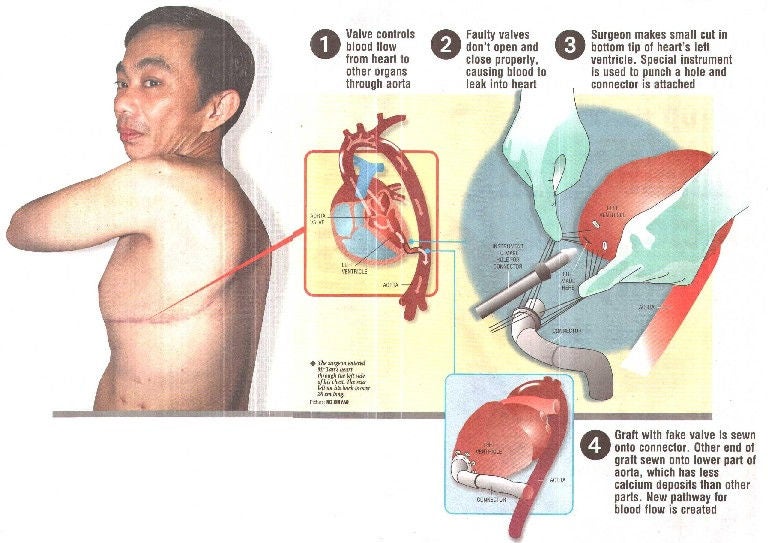
His heart valve was not working properly. Death was just months away. Mr Roy Tan Loon Inn, 41, was ready to try anything. In April, when his surgeon suggested an operation never done before in Singapore, he agreed immediately.
Even worldwide, the procedure is very rare. A survival rate was not available.
It includes punching a hole in the heart and creating an artery bypass.
The surgeon then puts in an artificial heart valve.
FRIGHTENING
It may sound frightening.
But Mr Tan's choice was simple: Do this or die.
Said Mr Tan, a pub chef: "Most normal people would feel uncomfortable if they knew it was the first time the doctor was doing it.
"They may feel like guinea pigs. But I had no choice. It was do or die. So of course I said yes." Mr Tan's condition was diagnosed in December.
Blood that was supposed to be pumped out to the rest of his body through the aorta kept leaking back into the heart because the valve did not close completely.
The aorta is the largest artery in the human body, originating from the left ventricle of the heart and taking oxygenated blood to all parts of the body,
Every breath he look was torturous and he could not walk more than two steps.
To make matters worse, the normal procedure (open heart surgery to repair the heart valve by cutting through the aorta) was not possible in his case because of a childhood illness.
The radiation treatment he had taken then to fight the disease had increased calcium deposits in the top part of his aorta.
Said Dr Kennv Sin, head and senior consultant, department of cardiothoracic surgery at National Heart Centre: "Any attempt to cut open the aorta would have meant risking the calcium deposits flying everywhere, including the brain which would have caused a stroke.”
As Dr Sin pondered Mr Tan's case, he remembered a visit he had made to a pharmaceutical company in the US a few years ago.
"One of the senior engineers there had shown me a product they made, called a connector,” said Dr Sin. He called the company in the US and ordered the connector for Mr Tan.
"It costs $10,000,” said Dr Sin. With the connector, he was able to create another pathway for the blood to flow.
"The new artificial valve solved Mr Tan's valve problem," said Dr Sin.
As Mr Tan had had radiation therapy to his chest, Dr Sin did not enter the heart from the front of the chest.
"We were worried about wound healing. Radiation therapy to a particular area can affect its ability to heal,” he said.
Instead he entered Mr Tan's heart through the left side of his chest.
The scar on Mr Tan's back is over 20 cm long. The operation took nearly three hours.
Said Mr Tan: "When I woke up from the surgery, I knew I was better at once. I was not breathless any more and did not feel tired.” He went home after six days.
HE SLEEPS WELL NOW
"I can walk properly now and sleep really well," said Mr Tan, He has also put back the weight he had lost.
Said his relieved wife, Mrs Jo Tan, 41, a dental nurse: "When he was sick he looked like a ghost, so pale and so weak. He went down to 54kg.
“Now he's 62kg.”
The surgery and hospitalisation cost $26,000, most of which was covered by government subsidies and Mr Tan’s insurance.
He has yet to return to work as he is still recuperating.
“I hope to find a lighter type of job when I have fully recovered," he said.
Said Dr Sin: "Patients who cannot have conventional surgery do not have to give up hope.”
He hopes to spread that message to other patients and doctors.
The Heart Centre does 100 to 200 cases of conventional valve repair surgery a year.
Source: The New Paper © Singapore Press Holdings Limited. Permission required for reproduction.













 Get it on Google Play
Get it on Google Play